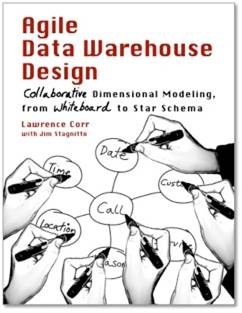
BACKGROUND
I first worked with Lawrence Corr back in 2002 whilst I was designing content in the Analytical Applications Division (AAD) of the BusinessObjects Product Group. At that time Lawrence was engaged as an external consultant to BusinessObjects, critiquing and advising us (AAD), on our BusinessObjects data warehouse design. Back then Lawrence also gave me my first formal dimensional modeling training when I attended his Data Warehousing Design Techniques course. Lawrence already had a very impressive reputation and was closely associated with Ralph Kimball.
It was therefore of interest to me when Lawrence said that he was writing a new book entitled Agile Data Warehouse Design. Here’s what I found…
AGILE
There are two initial points to make about the book. Firstly, about the title of the book Agile Data Warehouse Design. Despite what the title might initially suggest it does not explain how to deliver a data warehouse through existing well known Agile techniques such as functioning as a scrum master or doing Extreme Programming (XP). It is rather about a structured method of bringing together Business Intelligence requirements analysis and dimensional modeling techniques using an Agile mindset. The goal being to deliver logical models that work, in a highly time efficient fashion. As such the Agile Manifesto is listed at the rear of the book and it is easy to see how the methods described meet the aims laid out in the manifesto.
PRACTICAL METHOD
Secondly, Agile Data Warehouse Design is a pragmatic book. It is not just agile theory alone. It will provide you with practical techniques, artifacts, and tools that will enable you to model successfully. I say that because I have already implemented these techniques, known as BEAM, extensively at a leading insurance company, at a leading car manufacturer working across all their vehicle brands and for a well known high street retailer. I have found that business users became actively engaged when introduced to the BEAM technique of the 7Ws (more on the 7Ws later). Furthermore the BEAM tools made it easy for end users to contribute in an intelligent and structured way. That said, the business users did not need to understand the BEAM techniques themselves; in fact I never mentioned that we were using BEAM at all and they didn’t need to know. They simply attended the interviews and enjoyed having their brains picked and taking joint ownership of the developing dimensional model.
BI BREAKPOINTS
I became all the more interested in reading Agile Data Warehouse Design when I began to realise that it tackles head on several key ‘BI Breakpoints’: the term used by BI System Builders to describe weaknesses in an End to End BI solution that can become points of failure. While the term is not explicitly used in the book it quickly became clear to me that the BEAM method will help developers address the specific BI Breakpoints between Business Analysis and Data Warehouse design. As such, I found Agile Data Warehouse Design to be highly complimentary to the Cornerstone Solution® BI method. The Cornerstone Solution® End to End BI method is used by BI System Builders to address BI Breakpoints. You can read more about BI Breakpoints here.
WHICH BI BREAKPOINTS DOES BEAM ADDRESS?
BEAM addresses BI Breakpoints around business analysis and dimensional model design. A key issue for effective dimensional modeling, that I’ve faced many times, is that it requires the combination of three different contributing skill sets: Business Domain Expertise, Business Analysis, and Dimensional Modeling. The domain expertise is provided by the business. However, it is the role of the business analyst (BA) to extract that expertise, understand the business process area and then document the business requirements. To do this successfully requires the ability to ask the right questions. Once the BA’s document is available it is translated into a dimensional model by the Business Intelligence and Data Warehouse (BI/DW) team.
Generally speaking I observe that BAs will have a predominantly business background while dimensional modelers (DMs) a technical one. Frequently a BA is assigned to go to the business and gather user requirements, the result of which is a copious document. Once the document is complete it is handed over to the BI/DW team to work with. Although the document is useful, typically it will not explicitly describe critical dimensional modeling design elements such as fact granularity, and fact and dimension table types and relationships as required by the BI/DW team for development purposes. Consequently, this handover can become a BI Breakpoint.
The BI/DW team will attempt to interpret the business analysis document as best they can. However, issues can arise because the BI/DW team had no involvement during the analysis stage and could not ask pertinent questions whilst the business analysis was being undertaken. After sign-off of the business analysis document the BA may move onto another project and not be available to provide further help. As contractors and consultants are often used as BA’s they may even have left the business all together. This can cause a chasm of understanding to open up between the BI/DW team and what the business users had been describing and requesting. Needing clarification or finding information missing and not knowing or wanting to approach the business again the BI/DW team may fall back onto something that is more securely under their control as a means to drive their modeling effort – source system data analysis.
The risk of building out dimensional models based on source system analysis is that the final tables will be close in design to the source data but may not model the business process area or meet business user needs. The tables may not meet business requirements and they may not be a true dimensional design at all. To my mind this is a failing, because ignoring for the moment the new SAP HANA, I have always found dimensional models to be the most effective performance design for use with SAP BusinessObjects tools against a relational database and the best way to think of business process measurement in general.
To help avoid the BI Breakpoint that can occur between the BA and the BI/DW developers we have the notion of cross-functional teams. A cross-functional team is superior to the structure previously mentioned. The team members work closely and simultaneously together often in the same project room. The DM from the BI/DW team sits in on the BA’s interviews with the business users and starts to construct the logical model design. The dimensional modeler can ask clarification questions directly to the BA and business user at any point in the process. Furthermore the evolving logical model design can be frequently replayed to the rest of the team to confirm it. In my experience the cross-functional team has been more successful than the polarised BA and BI/DW (chasm-forming) teams. BEAM takes the concept of the cross-functional team much further and provides an intelligent and effective framework for the BA and BI/DW teams to work together in. Following the BEAM method is an effective antidote to creating BI Breakpoints.
WHAT IS THE BEAM METHOD?
BEAM stands for Business Event Analysis and Modeling. As the name suggests it combines elements of requirements analysis and data modeling. Its key concept is to use 6 dimensional types and a measure type (the 7Ws) to identify and then elaborate business events. BEAM concentrates on business events rather than known reporting requirements so as to model whole business process areas. This provides a major advantage. Modeling a business process area yields a design that can be readily scaled as requirements grow. Modeling for a set of reporting requirements alone can lead to a narrow solution. ‘Narrow’ because the design may not lend itself to be scaled when new requirements are on boarded. Therefore, the BEAM approach helps avoid the BI Breakpoint of non-scalability. BEAM’s 7W approach also lays a solid foundation for ad-hoc reporting and self-service BI by teaching business users – by stealth – to think dimensionally.
The 7Ws used by BEAM are: Who, What, When, Where, How, How Many, and Why. A similar conceptual technique is used in investigative journalism to ensure full story reporting coverage. For a specified business process area the BEAM idea is to identify event stories by asking a ’who does what’ question and then expressing the answer as a simple story. An example of this would be ‘traders buy commodities’. A series of these ’who does what’ stories are captured and then the remainder of the 7Ws such as the ‘when’ and ‘where’ are asked to drive out their interesting details. All the results are documented in a BEAM table template.
The BEAM table template is one of several tools employed, you will also learn how to use the BEAM tools of hierarchy charts, timelines, event matrices, and enhanced star schemas. The BEAM method will then take you through modeling events, dimensions, processes and star schemas to provide working software and documentation as detailed in the Agile Manifesto.
From the information gathered in the Business Event Analysis stage it is then possible to easily identify dimension and fact table types. Dimension and fact table patterns are explained in the second half of the book ‘Modeling’. If you are new to dimensional modeling you will learn much from the vast design and implementation experience of Lawrence and his co-writer Jim Stagnitto. The BEAM method and notation walks you through a natural continuum from the interview stage right through to the end dimensional model.
When the BEAM method is properly understood and implemented it will effectively bridge the gap (BI Breakpoint) between the BA and the DM. Both the BA and the DM can work together using BEAM or for someone with hybrid skills the two roles can become one. In summary Agile Data Warehouse Design is a thoroughly well written book that addresses BI Breakpoints and brings with it four key benefits. It will show you how to practically apply an effective combined analysis and modeling method (BEAM). It will help engage business communities so that full business process areas can be modelled making your solution scalable. It will lower costs to the business by reducing analysis and modelling time. It will reduce the risk of a project struggling by delivering working software and documentation on time.
You can buy Agile Data Warehouse Design from Amazon and find out more about BEAM and matching agile/dimensional modelling courses on Lawrence’s Decision One Consulting web site.
 Creating BI Architecture That Stands Out
Creating BI Architecture That Stands Out




You must be logged in to post a comment.